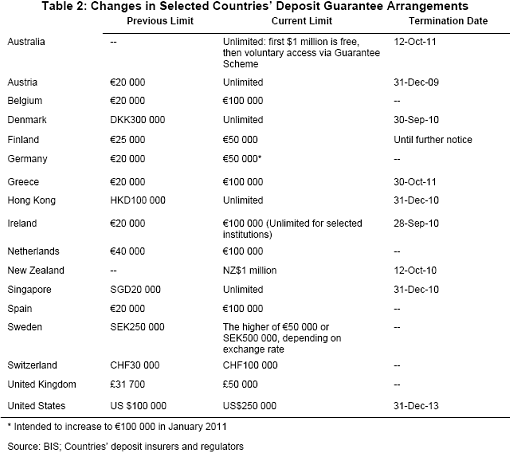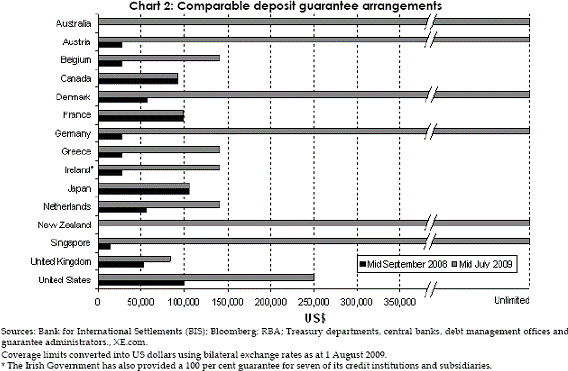Chapter 2
The deposit guarantees
The introduction of the deposit guarantees
2.1
The Government developed the deposit guarantee in consultation with
Treasury, the Reserve Bank of Australia (RBA) and APRA, following discussions
going back to early 2008.[1]
The Government had announced in June 2008 its intention to introduce a
'Financial Claims Scheme' with a cap of $20,000 per depositor.
2.2
On 11 October, the Coalition called for the proposed cap to be raised
from $20,000 to $100,000 in response to the deterioration in the international
financial environment.[2]
2.3
On Sunday 12 October, after a meeting with the Secretary of the
Treasury, the Treasurer announced a package of changes to Australia's financial
system, including an uncapped guarantee for three years on all deposits of
Australian authorised deposit‑taking institutions.
2.4
The immediate aftermath of the announcement saw a run on redemptions for
those institutions not benefiting from the proposed guarantee, together with
controversy surrounding the extent to which the Government fully consulted on
the proposed changes with the appropriate agencies, specifically the RBA.
2.5
From there the chronology was as follows:
The Australian Government also moved to reassure depositors
and investors in Australian ADIs, and to ensure that Australian ADIs were not
disadvantaged compared to banks in other countries, by announcing guarantee
arrangements for deposits and wholesale funding. This was announced on 12
October, with further details – including a guarantee fee on large deposits –
announced on 24 October following advice from the Council of Financial
Regulators. The Government noted in its announcement that the guarantee scheme
arrangements would be reviewed on an ongoing basis and revised if necessary.
The guarantee arrangements became fully operational on 28 November after a
period of close co‑ordination between Council agencies – in consultation
with ADIs – to establish the necessary rules, processes, documentation and
architecture.[3]
2.6
Although it remains unclear to what extent the Government consulted and
fully considered the impact and potential intended and unintended consequences
of these measures, prior to first announcing them, what is evident from this
chain of events, is that the Government was struggling in terms of its response
to the financial crisis and that it found it frustrating that the Leader of the
Opposition was calling for needed reforms prior to their announcing them.
2.7
Nevertheless, the Australian government eventually moved further than
many other governments – even those facing more serious problems – in jumping
from no guarantee or deposit insurance to an unlimited scheme.[4]
This decision clearly increased the impact on non-bank financial institutions
outside the scheme, a matter taken up in Chapter 4.
The fee for deposits over $1 million
2.8
While the deposit guarantee as eventually implemented was not subject to
a cap, the guarantee offered for non-deposit forms of wholesale funding had a
fee. The Government's position is now that that it was therefore necessary to
impose a corresponding fee on very large deposits or there could be distortions
in the financial markets as wholesale funding became reconfigured as very large
'deposits' to benefit from the free guarantee. The Government set $1 million as
the threshold over which the fee would be payable, at the same rate as that
applying to wholesale funding.
2.9
As the Treasury Secretary put it:
A large deposit could in fact be a source of wholesale
funding for a financial institution...If we continue with an unlimited guarantee
for deposits, for which there is no charge, there is no insurance premium
charged, but at the same time for short-term wholesale funding, we say, ‘Yes,
there is a guarantee but there is a charge,’ then we will distort the
short-term money markets.[5]
2.10
For large deposits, there has been relatively little demand for this
guarantee, with the guarantee fee being paid on around $20 billion of deposits,
around 2 per cent of total deposits.[6]
The Reserve Bank and APRA report:
Liaison with ADIs suggests that most depositors with over $1
million are not seeking the guarantee when they have to pay for it. The major
exception is depositors with very conservative mandates, such as trustees and
councils.[7]
2.11
APRA-regulated foreign bank branches are eligible to apply for a
guarantee for liabilities from Australian residents with maturities up to the end
of 2009 but they have to pay a fee for all these liabilities.[8]
The threshold for the fee
2.12
The $1 million threshold above which the guarantee is no longer free is
essentially arbitrary. It was designed to be dramatically different to the
$20,000 cap envisaged for normal times and to provide sufficient assurance to
prevent bank runs.
2.13
It is hard to know whether $1 million was the 'right' amount to choose. As
Professor Harper put it:
...could they have done that with a guarantee of $250,000 or
$500,000 or $100,000? I do not know the answer to that. In a sense, what I am
saying is that I would far rather that the government erred on the side of too
big a hit than too small a hit, because you only get one chance to do that in
those circumstances. Fortunately, the government’s intervention worked and I do
not know if it would have worked at $500,000 or $250,000. If it had not worked,
the chances of a second round working would have been much lower and we would
have been in a much more difficult situation.[9]
2.14
Contrary to a view that bank runs result from small, less sophisticated
and informed, investors (whose concerns could be addressed by a relatively
small threshold), Professor Harper argued:
These things start in the wholesale markets. The
irrationality that you are talking about was amongst wholesale investment
funds. Frankly, the banks, including our major banks, stopped lending to each
other...you are not talking about ordinary Herald Sun-reading folk on the
train...The ones who ought to have known better were frightened to the point of
closing their balance sheets, not lending and hoarding cash—the whole lot. That
is why, in my view, the best thing to do was to convince people who had a lot
of money that it was all safe rather than the mums and dads with not that much.[10]
Criticism of the fee tiering
2.15
The fee structure matches that applying to the wholesale funding
guarantee. A controversial feature of both fee structures is the relation
between the fee and the credit rating of the ADI concerned. This is discussed
in the following chapter.
International comparison
2.16
Many comparable countries extended the coverage of their deposit
insurance schemes in the face of the crisis (Table 2.1 and Chart 2.1).
2.17
Comparing the Australian arrangements with those overseas, the Reserve
Bank and APRA comment:
The Australian arrangements share many common features with
those introduced in other countries although, on balance, the range of parameters
are generally at the more supportive end of those internationally.[11]
Table 2.1

Source: RBA & APRA, Submission
7, p 3.
Chart 2.1

Source: Treasury, Submission
22, p 12.
2.18
The Committee questions whether, in a country where banks have remained
well capitalised, highly profitable and well regulated, it was necessary to
take action 'at the more supportive end of those internationally' to achieve
the desired stability of the system, given some of the consequences discussed
in this report.
Corresponding obligations
2.19
Some witnesses argued that the provision of a deposit guarantee should
be associated with some increased obligations on banks:
...such conditions should include measures to safeguard
Australian jobs against practices such as off-shoring, maximise Australian
employment, lend responsibly and effectively to all market segments and require
the observation of social obligations ensuring that banks do not withdraw
services to disadvantaged communities or groups.[12]
2.20
There have also been suggestions that banks should be restrained in
their ability to increase housing loan interest rates (especially if the
Reserve Bank has not made a corresponding increase in its policy rate), charge
high interest rates on credit cards and pay executive salaries exceeding $1
million when they are benefiting from funding guarantees.[13]
2.21
As these matters are currently being examined by the Economics
Legislation Committee's inquiry into the Banking Amendment (Keeping Banks
Accountable) Bill, they are not pursued further here.
Navigation: Previous Page | Contents | Next Page